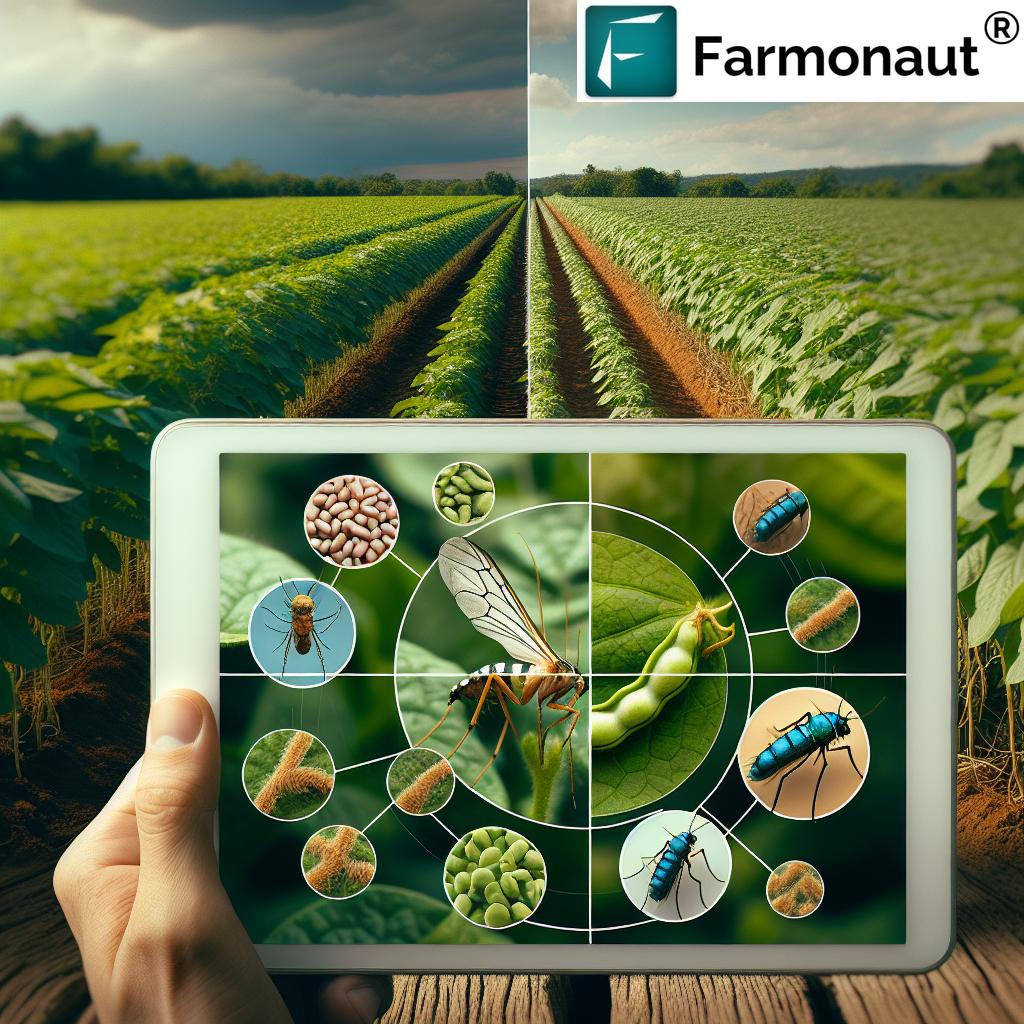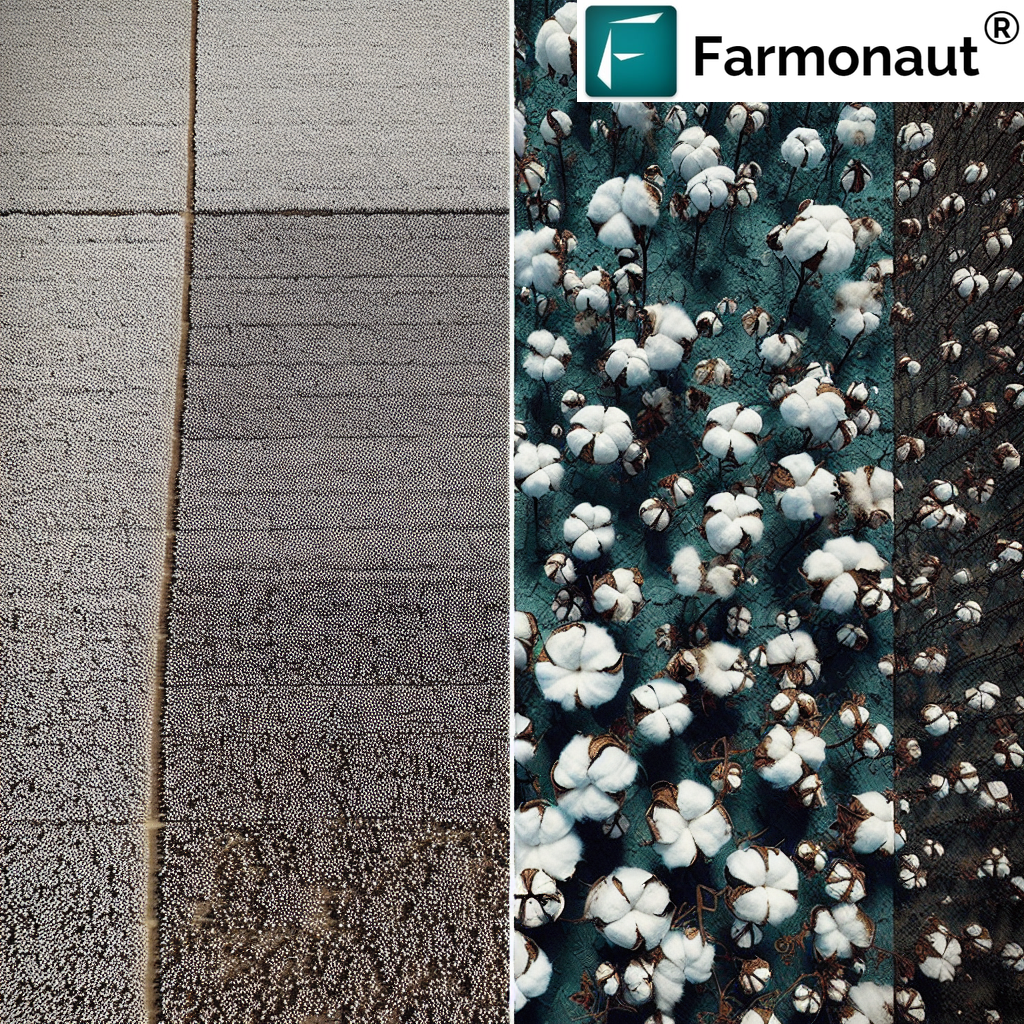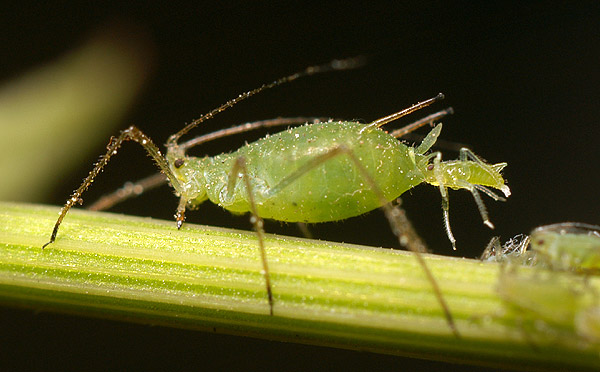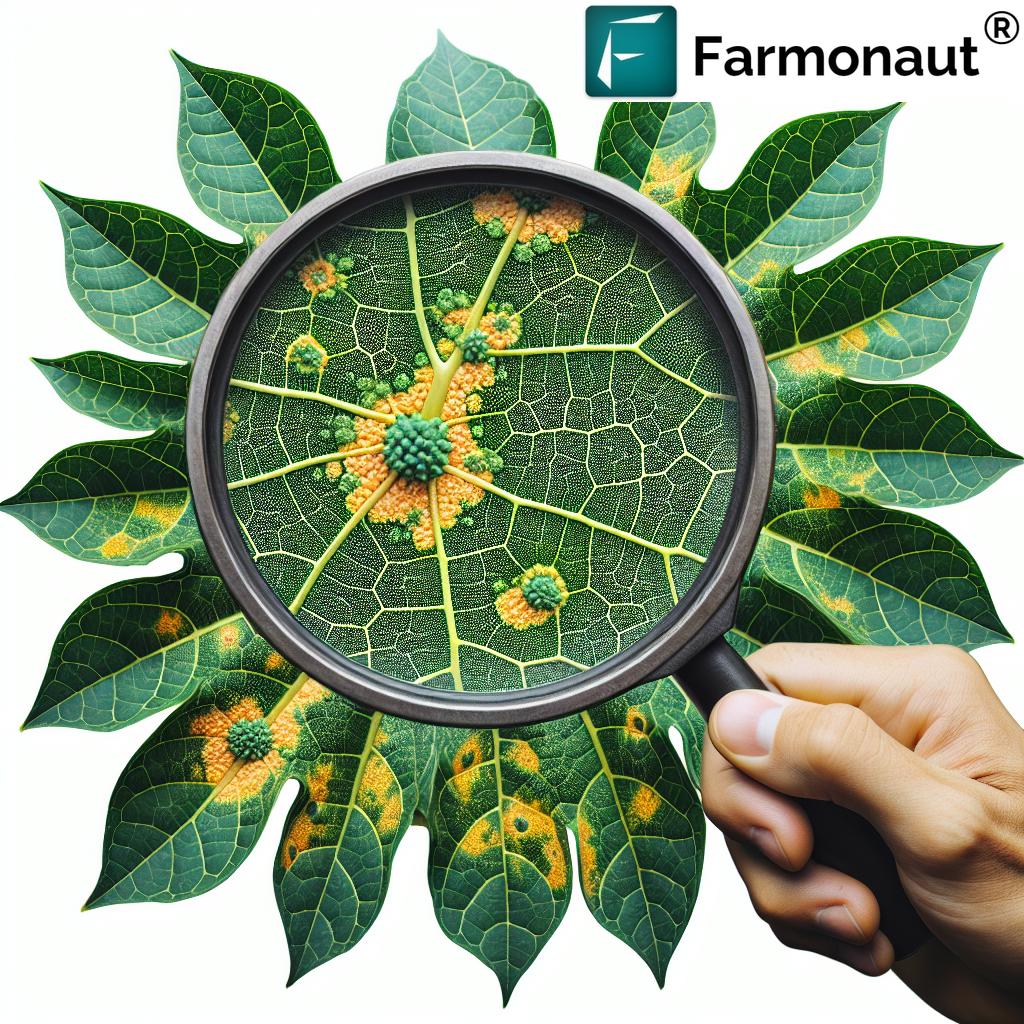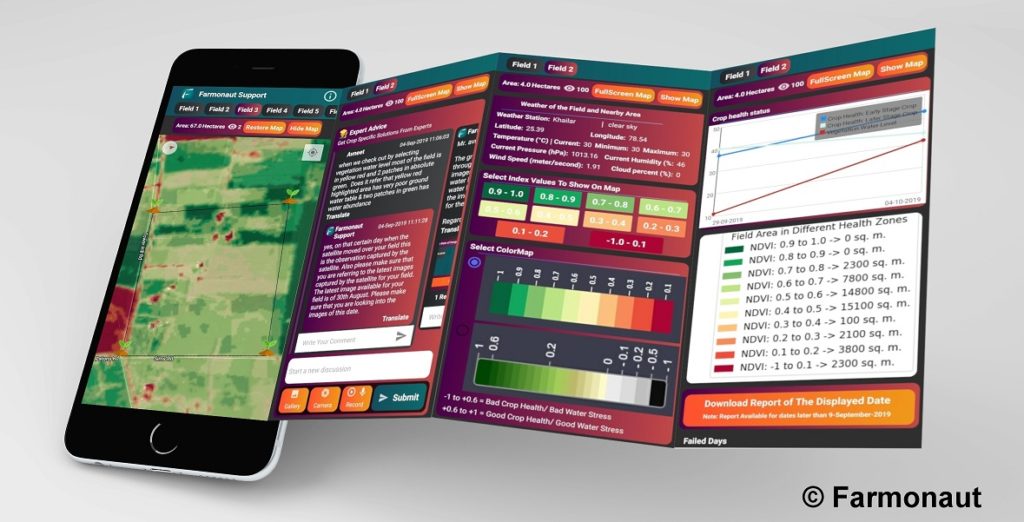Unlocking Plant Mysteries: Understanding Variegation and Chimeras in Sustainable Agriculture
“Variegated plants can have up to 3 distinct tissue types, creating unique pigmentation patterns in leaves and stems.”
Welcome to our comprehensive exploration of the fascinating world of plant variegation and genetic chimeras in sustainable agriculture. In this blog post, we’ll dive deep into these intriguing botanical phenomena, unraveling their mysteries and examining their implications for modern farming practices. As we journey through the realms of plant biology and genetics, we’ll discover how these unique characteristics create stunning visual displays in plants and influence their growth and development.
At Farmonaut, we’re passionate about leveraging cutting-edge technology to enhance agricultural practices. While our primary focus is on satellite-based crop monitoring and AI-driven farm management, we recognize the importance of understanding the fundamental aspects of plant biology. This knowledge forms the backbone of sustainable farming practices and helps us develop more effective agritech solutions.
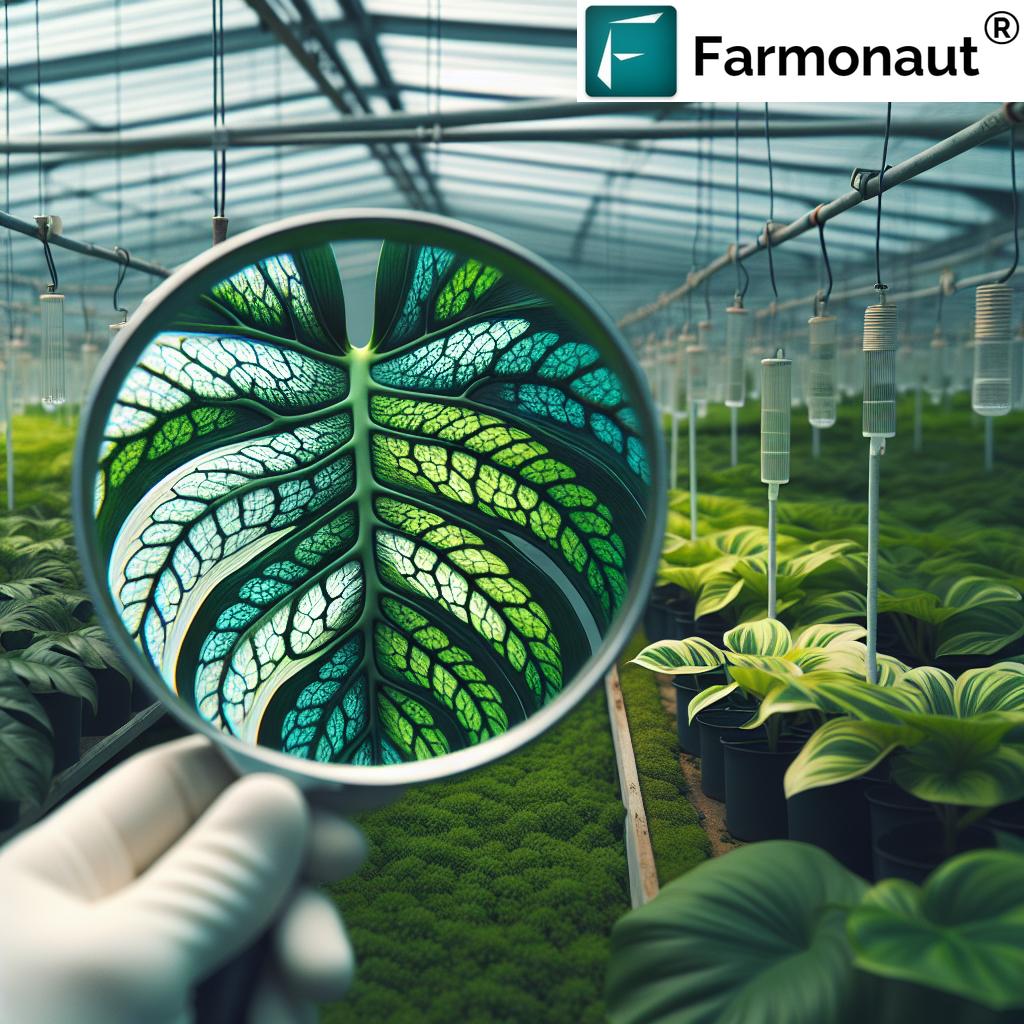
The Science Behind Plant Variegation
Plant variegation is a captivating genetic phenomena that results in diverse pigmentation patterns within plant tissues. These patterns can manifest as striking spots, blotches, streaks, or stripes in various colors, most commonly green, yellow, and white. But what causes this eye-catching abnormality in plants?
At its core, variegation is a result of certain plant tissues losing their ability to produce chlorophyll, the green pigment responsible for photosynthesis. This loss of chlorophyll production can occur due to several factors:
- Genetic mutations: Some variegations are caused by mutations in genes responsible for chloroplast development or chlorophyll synthesis.
- Chimeras: These are plants composed of two or more genetically distinct cell populations, leading to visible differences in tissue appearance.
- Viral infections: In some cases, viral infections can interfere with chlorophyll production, resulting in variegated patterns.
It’s crucial to note that variegation is not linked to diseases, pests, or mineral deficiencies, and typically doesn’t require specific control measures. In fact, many gardeners and plant enthusiasts actively seek out variegated plants for their unique and attractive appearances.
Understanding Genetic Chimeras in Plants
Genetic chimeras in plants are a fascinating subset of variegation. These plants exhibit a unique form of genetic mosaicism, where two or more genetically distinct cell populations coexist within the same organism. This phenomenon can result in striking visual effects, with different parts of the plant displaying distinct characteristics.
Chimeras can arise through various mechanisms:
- Mutation: A spontaneous genetic mutation in a group of cells can lead to a chimeric plant.
- Grafting: When tissues from two different plants are grafted together, the resulting plant may exhibit chimeric characteristics.
- Somatic crossing-over: This occurs when genetic material is exchanged between chromosomes during cell division.
The presence of chimeras in plants can have significant implications for their growth, development, and overall biology. Some chimeric plants may exhibit enhanced vigor or unique traits that make them valuable in horticulture or agriculture.

The Role of Chlorophyll in Plant Variegation
Chlorophyll production plays a crucial role in the appearance of variegated plants. In normal green plants, chlorophyll is abundant in all leaf tissues, giving them their characteristic color. However, in variegated plants, some tissues lack the ability to produce chlorophyll, resulting in white, yellow, or pale green areas.
This reduction in chlorophyll can have several effects on the plant:
- Reduced photosynthetic capacity: Areas without chlorophyll cannot perform photosynthesis, potentially impacting the plant’s overall energy production.
- Slower growth: Variegated plants often grow more slowly than their non-variegated counterparts due to reduced photosynthetic efficiency.
- Increased susceptibility to stress: Some variegated plants may be more sensitive to environmental stressors like heat or drought.
Despite these potential challenges, many variegated plants have adapted to thrive in various environments, making them popular choices in landscaping and horticulture.
Explore Farmonaut’s satellite-based crop monitoring solutions:
Plant Pigmentation Patterns: A Closer Look
The diverse pigmentation patterns observed in variegated plants and chimeras are truly a sight to behold. These patterns can take various forms:
- Marginal variegation: Colored edges on leaves
- Sectoral variegation: Distinct sections of different colors
- Marbled variegation: Irregular blotches or streaks
- Patterned variegation: Specific, repeating patterns
These patterns are not just visually appealing; they can also provide insights into the plant’s genetic makeup and developmental history. For instance, the distribution of variegated areas can sometimes indicate the presence of a chimera or reveal the timing of a genetic mutation during the plant’s growth.
Variegation and Chimeras in Commercial Crops
“Less than 1% of commercial crops exhibit natural variegation or chimera characteristics due to their rarity in nature.”
While variegated plants are popular in ornamental horticulture, they are relatively rare in commercial crop production. This rarity is due to several factors:
- Reduced yield: The decreased photosynthetic capacity of variegated plants often results in lower yields compared to their non-variegated counterparts.
- Increased vulnerability: Some variegated crops may be more susceptible to pests and diseases.
- Market preferences: Consumers are often accustomed to the appearance of traditional, non-variegated produce.
However, there are exceptions. Some variegated crops, particularly in fruit production, have found niche markets. For example, certain variegated citrus fruits are prized for their unique appearance and flavor profiles.
Sustainable Farming Practices and Variegated Plants
In the context of sustainable agriculture, variegated plants present both challenges and opportunities. While their reduced photosynthetic efficiency may require more resources to achieve comparable yields, their unique characteristics can be leveraged in several ways:
- Biodiversity: Incorporating variegated varieties in crop rotations can enhance genetic diversity in agricultural systems.
- Pest management: Some variegated plants may have natural resistance to certain pests, potentially reducing the need for chemical pesticides.
- Niche markets: Variegated crops can command premium prices in specialty markets, potentially offsetting lower yields.
At Farmonaut, we recognize the importance of biodiversity in sustainable agriculture. Our satellite-based crop monitoring tools can help farmers track the health and performance of both traditional and variegated crop varieties, enabling data-driven decision-making for optimal resource management.
Discover Farmonaut’s AI-driven farm management solutions:
Organic Pest Control Methods for Variegated Plants
While variegated plants are not inherently more susceptible to pests, their unique characteristics may require tailored approaches to pest management. Organic pest control methods are particularly well-suited for these plants, as they align with sustainable farming practices and can help preserve the plants’ delicate balance of tissues.
Some effective organic pest control methods for variegated plants include:
- Companion planting: Growing pest-repelling plants alongside variegated varieties
- Biological control: Introducing beneficial insects that prey on common pests
- Physical barriers: Using nets or row covers to protect plants from insects
- Organic sprays: Applying neem oil, insecticidal soaps, or other natural deterrents
These methods can help maintain the health and vigor of variegated plants without resorting to harsh chemical pesticides that may damage their sensitive tissues.
The Role of Plant Protection Products in Variegated Crop Management
While organic pest control methods are preferable, there may be instances where the use of plant protection products becomes necessary. When dealing with variegated crops, it’s crucial to approach the use of these products with caution:
- Sensitivity testing: Variegated plants may react differently to certain chemicals. Always test products on a small area first.
- Targeted application: Use precision application techniques to minimize exposure to non-target areas.
- Integrated Pest Management (IPM): Incorporate plant protection products as part of a broader IPM strategy, using them only when necessary.
- Monitoring: Regularly assess plant health and pest populations to determine the effectiveness of treatments.
At Farmonaut, our satellite-based crop monitoring technology can help farmers track the health of their variegated crops before and after the application of plant protection products, ensuring optimal use and minimizing environmental impact.
Agritech Solutions for Managing Variegated Crops
The unique characteristics of variegated plants and genetic chimeras present both challenges and opportunities for agritech solutions. At Farmonaut, we’re constantly innovating to provide tools that can help farmers effectively manage these special crops:
- Precision monitoring: Our satellite-based crop health monitoring can detect subtle changes in plant vigor, crucial for managing the often delicate balance of variegated plants.
- AI-driven insights: Our Jeevn AI advisory system can provide tailored recommendations for variegated crop management, taking into account their unique growth patterns and needs.
- Resource optimization: Our platform helps farmers optimize water and nutrient use, which is particularly important for variegated plants that may have different resource requirements compared to their non-variegated counterparts.
Explore Farmonaut’s API for custom agritech solutions:
Farmonaut API
API Developer Docs
The Future of Variegated Plants in Agriculture
As we look to the future, the role of variegated plants and genetic chimeras in agriculture is likely to evolve. While they may remain relatively rare in large-scale commercial crop production, their potential in niche markets and sustainable farming practices is significant:
- Specialty crops: Variegated fruits and vegetables may gain popularity in high-end culinary markets.
- Ornamental agriculture: The demand for visually striking plants in urban farming and vertical gardening could increase the cultivation of variegated varieties.
- Research opportunities: Studying variegated plants and chimeras can provide valuable insights into plant genetics and development, potentially leading to breakthroughs in crop improvement.
At Farmonaut, we’re committed to supporting farmers and researchers as they explore these new frontiers in agriculture. Our advanced satellite monitoring and AI-driven analytics can provide the data and insights needed to successfully cultivate and study these unique plant varieties.
Comparison of Variegated Plants and Genetic Chimeras
| Characteristic | Variegated Plants | Genetic Chimeras |
|---|---|---|
| Definition | Plants with distinct color patterns in leaves or stems | Plants composed of two or more genetically distinct cell populations |
| Cause of coloration | Genetic mutation or viral infection affecting chlorophyll production | Presence of genetically distinct tissues |
| Chlorophyll production | Reduced or absent in some areas | May vary between different tissue types |
| Typical appearance | Spots, blotches, streaks, or stripes | Distinct sections with different characteristics |
| Growth rate (estimated) | Often slower than non-variegated plants | Can vary depending on the genetic makeup |
| Rarity in commercial crops (estimated %) | < 1% | < 0.5% |
| Impact on plant health | May have reduced vigor due to less chlorophyll | Can exhibit enhanced vigor or unique traits |
| Sustainable farming considerations | May require more resources, potential for niche markets | Could contribute to biodiversity, potential for novel traits |
Frequently Asked Questions
- Q: Are variegated plants less healthy than non-variegated plants?
A: Not necessarily. While variegated plants may have reduced photosynthetic capacity, many have adapted to thrive in their environments. However, they may grow more slowly and require more careful management. - Q: Can variegation be induced in plants?
A: In some cases, yes. Variegation can be induced through techniques like grafting or exposure to certain viruses. However, these methods should only be attempted by experienced horticulturists. - Q: Are all white or yellow areas on leaves a sign of variegation?
A: No, not all discolored areas indicate variegation. Some discoloration can be caused by nutrient deficiencies, diseases, or pest damage. It’s important to correctly identify the cause of any unusual coloration. - Q: How can farmers effectively monitor the health of variegated crops?
A: Advanced technologies like Farmonaut’s satellite-based crop monitoring can provide valuable insights into the health and vigor of variegated crops, allowing for timely interventions and optimized management. - Q: Are there any commercial crops that are commonly grown as variegated varieties?
A: While rare, some variegated fruits, particularly citrus varieties, are grown commercially. However, they typically occupy niche markets rather than large-scale production.
Conclusion
Variegated plants and genetic chimeras represent fascinating aspects of plant biology that intersect with sustainable agriculture practices. While these unique plant varieties present certain challenges in terms of growth and management, they also offer opportunities for biodiversity, niche market development, and advancing our understanding of plant genetics.
As we continue to explore sustainable farming practices and leverage advanced agritech solutions, the role of variegated plants in agriculture may evolve. At Farmonaut, we’re committed to providing the tools and insights needed to effectively manage all types of crops, including these botanical wonders.
By combining traditional agricultural knowledge with cutting-edge technology, we can unlock the full potential of variegated plants and genetic chimeras, contributing to a more diverse, resilient, and sustainable agricultural future.
Experience Farmonaut’s advanced crop monitoring solutions:
As we continue to unlock the mysteries of plant variegation and genetic chimeras, we’re excited about the potential applications in sustainable agriculture. By leveraging advanced monitoring tools and AI-driven insights, farmers can make informed decisions about crop management, resource allocation, and pest control strategies for these unique plant varieties.
At Farmonaut, we’re committed to supporting sustainable farming practices through innovative technology. Whether you’re managing traditional crops or exploring the potential of variegated varieties, our platform provides the data and insights you need to optimize your agricultural operations.
We invite you to explore our range of solutions and join us in shaping the future of sustainable agriculture. Together, we can harness the power of technology to cultivate a more resilient, diverse, and productive agricultural landscape.







